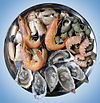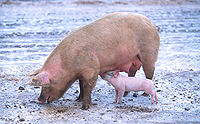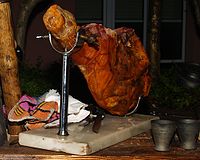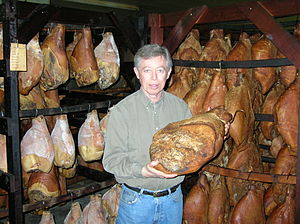- Ham
-
Ham is a cut of meat from the thigh of the hind leg of certain animals, especially pigs.[1] Nearly all hams sold today are fully cooked or cured.
Contents
Etymology
The word ham is derived from the Old English ham or hom meaning the hollow or bend of the knee.[2]
Regional use
Bulgaria
Elenski but is a dry-cured ham from the town of Elena in northern Bulgaria and a popular delicacy throughout the country. The meat has a specific taste and can be preserved in the course of several years, owing much to the unique process of making the product and the climatic conditions of the part of Stara Planina where Elena is located.
Croatia
In the coastal regions of Croatia; Istria, Dalmatia and Croatian Littoral, as well as in Lika a form of Ham known as "Pršut" is made. This is smoked and dried ham which is pressed and is very popular. The most popular pršuts come from town of Drniš and village Posedarje in Dalmatia. The popularity of pršut has helped it spread to other regions of Croatia, Bosnia and Herzegovina and other surrounding countries. Pršut is similar to Italian hams. In continental Croatia the "Šunka"-s are made. Šunka is Croatian word for ham. It is not pressed but in other ways it is similar as Pršut but not as popular.
China
Chinese dry-cured hams have been recorded in texts since prior to Song dynasty and used in myriad dishes. Several types are existent in Qing dynasty and used in dishes of stewing hams (火腿炖肘子), and vegetables, or for a wide variety of soup and important soup stocks. One of the most famous Chinese hams is the Jinhua ham, a dry-cured ham which is used to produce a dish known as "Buddha jumps over the wall". Jinhua ham is used in Chinese cuisines to flavor stewed and braised foods as well as for making the stocks and broths of many Chinese soups. The ham was awarded first prize in the 1915 Panama International Merchandise Exhibition.[3]
France
Bayonne Ham or Bayonne is an air dried salted ham that takes its name from the ancient port city of Bayonne in the far South West of France (Le Pays Basque or Basque country).
Jambon de Paris is a wet-cured, boneless ham, which is served cold in thin slices and is a favourite of French families, especially children, to fix a quick meal.
Germany
Regional varieties of dry-cured, smoked hams include:
- Ammerländer Schinken, from the Ammerland area of North Germany. It is cured using a dry mixture of sea salt, brown sugar, and spices.
- Schwarzwälder Schinken, from the Black Forest region. It is seasoned, dry cured, then smoked over sawdust and fir brush.
- Westfälischer Schinken, produced from acorn-fed pigs raised in Westphalia. The resulting meat is dry cured and then smoked over a mixture of beechwood and juniper branches.[4]
Italy
In Italy, ham is called prosciutto, and can be either cured (prosciutto crudo) or cooked (prosciutto cotto).
Earliest evidence of ham production in Italy comes from the Republican Roman period (400-300 BC). Modern Italian and European Union legislation grants a protected designation of origin to several raw hams, which specify where and how these types of ham can be produced.
There are several such hams from Italy, each one with a peculiar production process. Parma ham, the so called Prosciutto di Parma, has almost 200 producers concentrated in the eastern part of Parma Province. Its production is regulated by a quality consortium that recognizes qualifying products with distinctive mark. Only larger fresh hams are used (12-13 kilograms). Curing uses relatively little salt, but can include garlic salt and sugar, producing a sweeter meat. After salting, the meat is sealed with pig fat over the exposed muscle tissue, which slows drying. Curing occurs over a minimum 12 months. No nitrates or spices are used in the process.
San Daniele ham (Prosciutto di San Daniele) is the most similar to Parma ham, especially the low quantity of salt added to the meat, and is the most prized ham. Other raw hams include the so called "nostrani" or "nazionali" or "toscani"; they are more strongly flavoured and are produced using a higher quantity of salt.
Prague ham (Prosciutto di Praga), although originated in Prague in the early 1900, is one of the most known Italian cooked hams, and the province of Trieste (which was part of Austria-Hungary until 1918, just like Prague) is the center of its production.[5]
Montenegro
Njeguška pršuta is an air-dried ham made in Njeguši, a village in Montenegro. Its particular flavor and aroma are the result of the mixture of sea and mountain air and wood burned during the drying process. It is similar to bacon.[6][7]
Philippines
In the Philippines, ham, or hamon as it is called (from the Spanish jamón) is normally associated with the Yuletide season. There are local variants of Jamón Serrano, and there is Hamon de Bola, which is a ball-shaped wet cured ham, among other varieties. There is also tinned processed ham—the type in cans—available year round in groceries. The main Christmas ham, similar to a Chinese ham and served in some Noche Buenas, is similar to a dry cured one, and it has to be cooked in a special sweet broth after being soaked to reduce the salt. Then the ham is scored and glazed, and roasted. Hamon de Bola, produced by the major Philippine food manufacturers, is usually offered as gifts to employees in most companies and government offices during the Yuletide season. This can be either baked or fried. As with the other dishes "localized" from foreign sources, the Philippine palate favors the sweeter variety of ham.
Portugal
In Portugal, besides several varieties of wet-cured hams called fiambre (not to be confused with the Guatemalan dish, also called fiambre), the most important type of ham is presunto, a dry-cured ham similar to Spanish jamón and Italian prosciutto. There is a wide variety of presuntos in Portugal; among the most famous are presunto from Chaves and presunto from Alentejo made from black Iberian pig; (see also pata negra).
Romania
In Romania, ham is called şuncă/şonc/şoancă/jambon. Usually it is dry cured, always with granular salt; in Transylvania and Banat, paprika might be added.
Serbia
Most famous Serbian ham (pršut in Serbian) is produced in Zlatibor mountain region, especially Mačkat village, where annual ham festival is held every January. Zlatibor region feel the influences of mediterranean and continental climate and in this area is "wind rose" which is one of the main reasons for production of quality ham. Delicatessen products include beef, swine and sheep ham. Also famous delicacy is Užice ham (Užička pršut) produced in western Serbia, near Užice town. Also famous ham region is Vojvodina in the north, especially Banat. There are also quality ham products from Stara Planina region in the south-east Serbia, on the border with Bulgaria. Worth mentioning is traditional ham production in the Šumadija region.
Spain
One of the more exacting ham regulatory practices can be found in Spain, where ham is called jamón. Hams in Spain are not only classified according to preparation, but also the breed, the pre-slaughter diet and region of preparation are considered important.
The jamón serrano (Serrano Ham) comes from the white pig. The regional appellations of Spanish Serrano ham include the following:
- Cured ham of Trevélez, cured at least 1,200 meters above sea level. Cured hams from Trevélez are qualified to be among the “sweetest” cured hams due to the low degree of salting necessary for the drying and maturing processes to succeed properly. This is caused by the north winds coming from the high tips of Sierra Nevada.
- Teruel is cured at least 800 meters above sea level, with a minimum of a year of curing and aging.[8]
Jamón Ibérico (Iberian ham) comes from the black Iberian Pig, and is also classified depending on the amount of acorns they eat, which determines the ham quality. Spanish regulators[9] recognize three qualities:
- Jamón Ibérico Cebo hogs are fed only commercial feed.
- Jamón Ibérico Cebo Campo hogs are fed only commercial feed.
- Jamón Ibérico Recebo hogs are raised on commercial feed and fed acorns for the last few months of their lives.
- Jamón Ibérico Bellota hogs are fed a diet almost exclusively of acorns (bellotas), the most famous.
The regional appellations (D.O.) of Iberian ham include the following:
- 'D.O. Los Pedroche' with Protected Denomination of Origin, from Córdoba (Andalusia).
- 'D.O. Jamón de Huelva' and Jabugo, a full-flavored ham made in Huelva (Andalusia). Jabugo is a small village in Huelva.[10]
- 'D.O. Guijuelo', in the province of Salamanca, in the cities of Guijuelo, Gredos and Béjar.
- 'D.O. Dehesa de Extremadura', made in Cáceres and Badajoz.
United Kingdom
British ham is closely associated with the older Wiltshire cure process[11] rather than the newer Sweet cure.[11] Gammon steaks are thick cut and circular in shape. The word Gammon derives from the Old Northern French word jambe for hind-leg of the pig,[12] and may also be used to refer to bacon. The depth of meat to the bone is greatest at the top of the hind limb; cutting this piece from the side and curing it separately therefore cures the meat thoroughly, easily, and this cut is the original and to this extent authentic form of Gammon.[13] Gammon is usually smoked.
York ham[14] is a mild-flavoured ham, lightly smoked and dry-cured, which is saltier but milder in flavour than other European dry-cured hams.[15] that has delicate pink meat and does not need further cooking before eating. It is traditionally served with Madeira Sauce.[16][17] Folklore has it that the oak construction for York Minster provided the sawdust for smoking the ham.[18]
United States
The United States largely inherited its traditions relating to ham and pork from 17th-century Britain and 18th-century France, the latter especially in Louisiana. The French often used wet cure processed hams that are the foundation stock of several modern dishes, like certain gumbos and sandwiches. Until the very early twentieth century, men living in the southern Appalachians would drive their pigs to market in the flatlands below each Autumn, fattening up their stock on chestnuts and fallen mast, much like their Scottish forebearers did for centuries. Further, archaeological evidence suggests that the early settlers of Jamestown (men largely from the West Midlands) built swine pens for the pigs they brought with them and, once established, also carried on an ancient British tradition of slaughtering their pigs and producing their pork in mid-November. To this day, the result is that in many areas, a large ham, not a turkey, is the centerpiece of a family Christmas dinner.
In the United States, ham is regulated primarily on the basis of its cure and water content. The USDA recognizes the following categories:
Fresh ham is an uncured hind leg of pork. Country ham is uncooked, cured, dried, smoked-or-unsmoked, made from a single piece of meat from the hind leg of a hog or from a single piece of meat from a pork shoulder (picnic ham). Virginia's famous Smithfield ham, a country ham, must be grown and produced in or around Smithfield, Virginia, to be sold as such. Similar, lesser known hams from Tennessee and the Appalachians have a similar method of preparation, but are more likely to include honey in their cures and be hickory smoked.
For most other purposes, under US law, a "ham" is a cured hind leg of pork that is at least 20.5% protein (not counting fat portions), and contains no added water. However, "ham" can be legally applied to "turkey ham" if the meat is taken from the turkey thigh. If the ham has less than 20.5% but is at least 18.5% protein, it can be called "ham with natural juices". A ham that is at least 17.0% protein and up to 10% added solution can be called "ham—water added". Finally, "ham and water product" refers to a cured hind leg of pork product that contains any amount of added water, although the label must indicate the percent added ingredients. If a ham has been cut into pieces and molded, it must be labelled "sectioned and formed", or "chunked and formed" if coarsely ground.
Sugar is common in many dry hams in the United States; it is used to cover the saltiness. The majority of common wet-cured ham available in U.S. supermarkets is of the "city ham" or "sweet cure" variety,[11][19] in which brine is injected into the meat for a very rapid curing suitable for mass market. Traditional wet curing requires immersing the ham in a brine for an extended period, often followed by light smoking.
In addition to the main categories, some processing choices can affect legal labeling. A 'smoked' ham must have been smoked by hanging over burning wood chips in a smokehouse or an atomized spray of liquid smoke such that the product appearance is equivalent; a "hickory-smoked" ham must have been smoked using only hickory. However, injecting "smoke flavor" is not legal grounds for claiming the ham was "smoked"; these are labeled "smoke flavor added". Hams can only be labelled "honey-cured" if honey was at least 50% of the sweetener used, is at least 3% of the formula, and has a discernible effect on flavor. So-called "lean" and "extra lean" hams must adhere to maximum levels of fat and cholesterol per 100 grams of product.
One of the most popular and expensive hams in the United States is Smithfield or Virginia ham. Through a special curing process, Smithfield ham ages. In that time mold may grow on the outside of the ham, while the rest of the meat continues to age. This process produces a distinctive flavor, but the mold layer must be scrubbed off the ham before being cooked or served.[20]
Turkey ham, a boneless product made from pressed turkey thigh meat, is a popular low-fat alternative to traditional ham in the US.[21]
Spiral sliced ham has become popular option for bone-in or boneless hams sold in the US.[22] In the spiral cutting process, the ham is firmly affixed, on the top and bottom, to a rotating base, which is gradually lowered as a blade is applied. This creates one single continuous slice.[23]
Tinned ham
Tinned ham (more commonly known in the United States as "canned ham" is a meat product that is sold exclusively in tins (or cans). The ham itself is usually formed from smaller cuts of meat, cooked in the can, and is often covered in an aspic jelly during the canning process. Two versions are available, perishable and shelf-stable. Tinned ham is usually sold in supermarkets and convenience stores.
See also
- Beef aging
- Canadian bacon
- Christmas ham
- Spam - a chopped pork product
- York ham
- Honey Baked Ham
References
- ^ Anon. "Ham". The free online Dictionary. Farlex. http://www.thefreedictionary.com/Ham. Retrieved 8 October 2010.
- ^ Brown, Lesley, ed (2007). Shorter Oxford English Dictionary. II (Sixth ed.). Oxford: Oxford University press. p. 3611.
- ^ Wang Ang, Catharina Yung-Kang; Liu, KeShun; Huang, Yao-Wen (1999), Asian foods: science & technology, CRC Press, pp. 209–212, ISBN 9781566767361
- ^ Hormel.com
- ^ "Origins of 'Prosciutto di Praga' from the Friuli Venezia Giulia region (in Italian)". http://www.ersa.fvg.it/divulgativa/prodotti-tradizionali/carni-fresche/prosciutto-cotto-praga. Retrieved 2010-08-21.
- ^ "Montenegro Guide". MontenegroGuide.com. http://www.montenegroguide.com/cuisine/. Retrieved 2009-04-22.
- ^ "Recipes of Montenegro". www.colonialvoyage.com. http://www.colonialvoyage.com/ricette/eng/montenegro/index.html. Retrieved 2009-04-22.
- ^ Regulator Agency of the Serrano Ham D.O., Jamón de Teruel.com
- ^ Campaña informativa sobre los Productos del Ibérico del Ministerio de Agricultura de España
- ^ Regulator Agency of the Iberian Ham D.O. Jamón de Huelva
- ^ a b c A colour atlas of food quality control, section "Brine curing", pages 65 and 66. Jane P. Sutherland, A. H. Varnam
- ^ The romance of words, page 125, Ernest Weekley
- ^ Lawrie's meat science page 1. R. A. Lawrie, Ralston Andrew Lawrie
- ^ "Food Legends of the United Kingdom: York Ham". Information Britain. http://www.information-britain.co.uk/food/foodlegends/York%20Ham/. Retrieved 11 November 2009.
- ^ Lori Alden. "Cook's Thesaurus: Ham". Food Subs. http://www.foodsubs.com/MeatcureHams.html. Retrieved 5 October 2008.
- ^ "Home Cooking - Ham Varieties and Terminology". About.com. The New York Times Company. 16 September 2008. http://homecooking.about.com/library/weekly/blham.htm. Retrieved 5 October 2008.
- ^ "Recipe Favourites York ham and other recipes related to York ham". Recipe Tips. http://www.recipetips.com/search.asp?index=recipes&querytext=york+ham. Retrieved 5 October 2008.
- ^ "History of 57 & 59 Blossom Street". Oliver's Of The Mount. http://www.oliversofthemount.com/history.html. Retrieved 5 October 2008.
- ^ City ham Clovegarden
- ^ Cook's Thesaurus: Ham
- ^ Turkey Ham
- ^ Brilliant Food Tips and Cooking Tricks:5,000 Ingenious Kitchen Hints, Secrets, Shortcuts, and Solutions, page 228, David Joachim
- ^ Method for spirally slicing boneless meat PatentStorm, US patents
External links
- Ham history
- United States Department of Agriculture: Focus on Ham
- Dehesa de Extremadura
- Ham Varieties and Terminology at About.com
- Cook´s Thesaurus: ham
Meat Poultry/Game 

Livestock Fish/Seafood Crab • Crayfish • Lobster • Prawn • Shrimp • Anchovy • Basa • Bass • Catfish • Carp • Cod • Crappie • Dolphin • Eel • Flounder • Grouper • Haddock • Halibut • Herring • Kingfish • Mackerel • Mahi Mahi • Marlin • Milkfish • Orange roughy • Perch • Pike • Pollock • Salmon • Sardine • Sole • Swordfish • Tilapia • Trout • Tuna • Walleye • Whale
Cuts / Preparation Other Butchery • Ethics • Preservation • Slaughter • Red meat • White meat
Ham dishes Topics Books and movies Pigs Domestic SelectionHusbandryPig farming • Intensive pig farming • Sty • Pannage • Pig toilet • Hog oiler • Gestation crate • Cross-fostering • Swine diseases • SwineherdAs food or
other productPig slaughter • Pig scalder • Suckling pig • Pork • Ham • Bacon • Lard • Blood • Dishes • Pig bladderOther uses
Wild
FeralPigs in culture Iron Age pig • Miss Piggy • Porky Pig • "The Three Little Pigs" • Babe • Charlotte's Web • The Sheep-PigCategories:- Cold cut
- Thanksgiving food
- Christmas food
- Easter food
- Ham
- Garde manger
- Charcuterie
Wikimedia Foundation. 2010.












